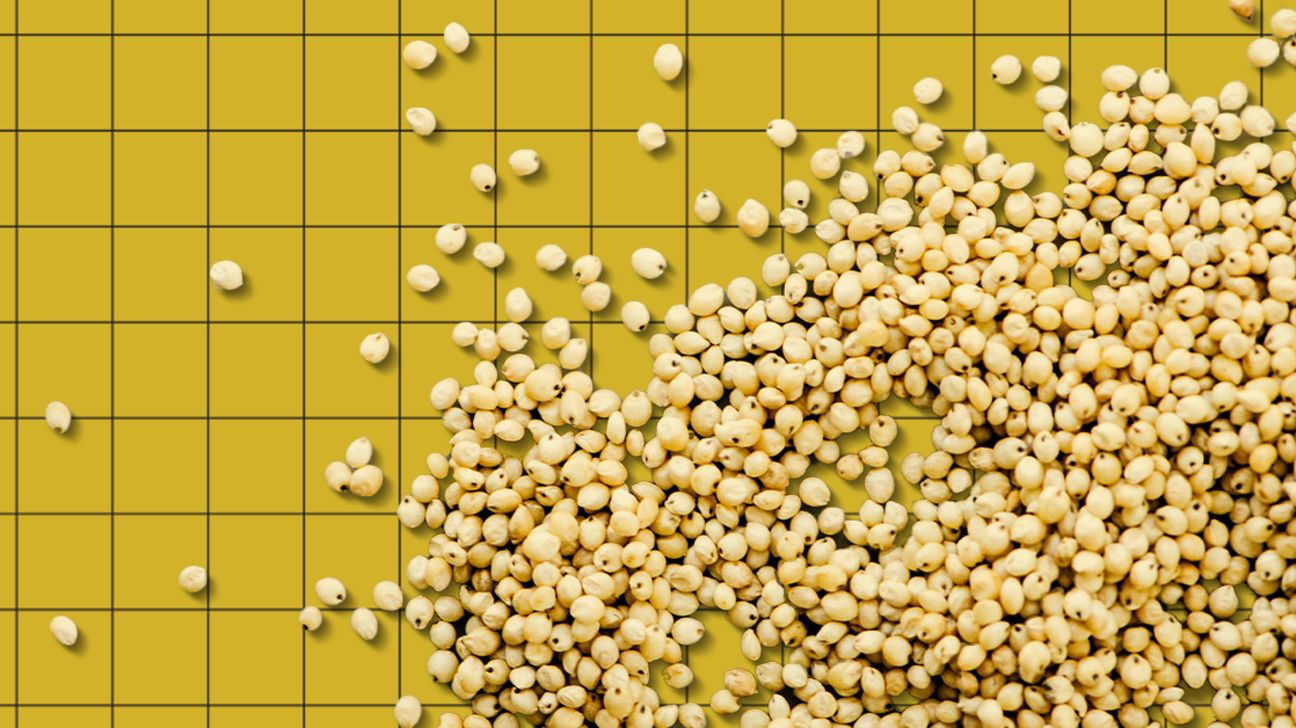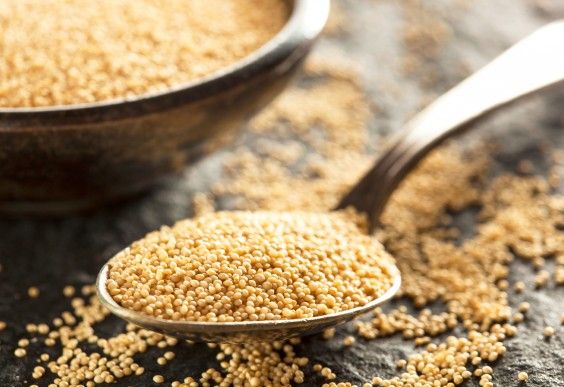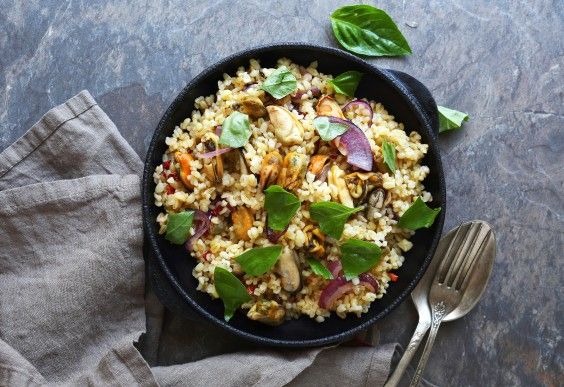There’s more to whole grains than just… wheat. That means there are plenty of ways to add variety to your meals while keeping your whole grain intake tip-top.
Unlike more-processed grains, whole grains still contain their most nutritious components — the germ, bran, and endosperm. They provide a whole bunch of fiber and a wide range of health benefits, which we’ll break down for you in this article.

You may be familiar with oatmeal, whole-wheat pasta, and even quinoa. But what’s left when you’ve had your fill of these whole-grain heroes?
Here are 17 grains you’ve probably never heard of that can be great additions to a healthy diet.
For when you’re no longer keen on quinoa.
1. Amaranth
Once considered a weed, amaranth is now known for its killer nutritional value.
This grain provides 5.17 grams of fiber and 9.35 grams of protein per cup, so it’s a more-than-capable stand-in for any other grain you can imagine.
It’s a great source of the amino acid lysine, as well as magnesium and calcium. And it contains squalene, a compound that was found to reduce tumor size in combination with chemotherapy in a 2019 study in mice.
Amaranth may also help lower cholesterol (at least according to a 2020 study in rabbits).
2. Kamut
Kamut is the brand name (and the most commonly used name) for the ancient Khorasan strain of wheat. It’s a great source of protein, with 9.82 grams per cup, and provides selenium, zinc, and magnesium.
A small 2013 study found that replacing semi-whole-grain wheat products in participants’ diets with Kamut products reduced their risk of metabolic syndrome and increased antioxidant activity in their bodies.
3. Millet
Once used primarily as bird feed, millet is now increasing in popularity among humans, whether it’s prepared like rice or made into flour and used in baked goods.
It’s a good source of protein, providing 6.11 grams per cup, and research suggests it can help regulate blood glucose levels.
Another benefit of keeping glucose levels in check: When blood sugar levels are steady, energy levels are steady. Millet might help you get through that whole video conference.
4. Teff
These teensy-weensy grains punch way above their weight class, nutritionally speaking. One cup of teff provides a heap of calcium (123 milligrams). It’s also a good source of vitamin C — plus, it’s gluten-free.
Teff primarily contains high-resistant starch, which lab studies suggest may help prevent colon cancer.
You don’t immediately digest resistant starches when they travel through your small intestine. Instead, they hang out in your large intestine, where bacteria feed on them.
In doing so, they create fatty acids that may make the environment less welcoming to bacteria that can harm your colon.
Teff’s tiny size (about the size of a poppy seed) allows it to cook quickly compared to other grains — it takes anywhere from 12 to 20 minutes, depending on the desired texture. Get that whole-grain delivery pronto!
5. Freekeh
This grain is freakin’ awesome! (Sorry, we had to.) (OK, we didn’t have to, but it was still fun.)
Basically, freekeh is wheat that’s harvested early (when the leaves are yellow and the seeds are green and soft) and then roasted to give it a smoky flavor.
Freekeh provides more than four times as much protein as brown rice and has a low glycemic index. Plus, it boasts a ton of fiber, which is good for your colon.
You can get freaky with freekeh by cooking it similarly to rice. It absolutely bangs in pilafs and risottos.
6. Farro
This ancient strain of wheat was allegedly rationed to Roman soldiers thousands of years ago. Geddem, Julius and friends!
Farro provides more fiber than brown rice or even the mighty quinoa, although not by much – a mere and you can swap either of these out for what Mr. Caesar himself called “Pharoah’s wheat.”
Farro provides fiber fit for a king (of Ancient Egypt)!
7. Barley
Barley dates back to the Stone Age and can take on many roles.
It’s available as a flour or meal for baked goods. Plus, you can add it to soups and stews in its pearled form. And it’s a key ingredient in beer and whiskey (some would argue this is its most important function).
Since it’s high in fiber (1 cup of the pearled stuff provides almost 6 grams), research suggests it might help prevent some chronic diseases and lower cholesterol.
8. Fonio
Fonio might be a tiny type of millet, but there’s a whole bunch of nutritional value in this humble grain.
It’s a great source amino acids, specifically methionine. This helps your liver process fat and cysteine (a member of the group of proteins that makes up hair, nails, and skin) and helps remove toxins from your liver and brain.
Fonio is one of the grains highest in magnesium, zinc, and manganese.
9. Sorghum
Sorghum is a gluten-free grain that can be a great option for folks with celiac disease.
Plus, it’s super versatile — you can cook it into porridge, pop it like popcorn, use it in flour form in baked goods, or even make beer from it. One study found that sorghum is a great source of antioxidants and might help reduce the risk of diabetes.
And look out in the future: Extract from sorghum bran (the hard outer layer of the grain that usually gets thrown out during processing) may soon become a popular food additive to bump up antioxidants in a cost-effective way.
Bargain!
10. Bulgur
Bulgur, another derivative of wheat, is the result of boiling, drying, and cracking wheat kernels. It’s incredibly versatile and cooks in about the same amount of time as pasta.
With 8.19 grams of fiber per cup, bulgur beats quinoa, oats, millet, buckwheat, and corn in that category. Super quick and ultra-fibrous? Sign us all the way up.
11. Spelt
Spelt is a type of wheat that’s higher in protein than other types, providing 10.7 grams per cup. You can easily sub spelt flour for wheat flour in recipes.
Although some studies have called spelt safe for folks with wheat intolerances, a 2018 review advises that they might still want to avoid it, since the research is spotty.
In other words, researchers haven’t yet spelt out whether it’s gluten-free. (Groan.)
12. Triticale
When wheat and rye meet and fall in love, they make triticale (“tri-ti-KAY-lee”).
This is a hybrid of the two grains that’s been around since the 1960s. In one study, it was found to contain a significant amount of antioxidant compounds.
People often eat triticale in the form of berries or oatmeal-like flakes.
13. Buckwheat
Native to Russia, buckwheat is actually not a type of wheat at all — it’s an herb. (🙀, right?)
It’s more closely related to rhubarb than to wheat, and it’s gluten-free. Manufacturers grind its seeds into flour or crush them to make groats, which you can cook like rice.
According to a 2011 study, buckwheat may help lower cholesterol levels by binding to cholesterol molecules and dragging them out of the body on their way through the digestive system.
Research also suggests buckwheat can be helpful in treating diabetes, because it provides a compound called quercetin that lowers blood glucose levels.
Buckwheat is the main ingredient in most soba noodles and some of these delicious pancakes.
14. Red rice
White rice, brown rice, red rice?! What is this multicolored madness?
A type of yeast that grows on rice grains yields this fun colored food — and the health benefits are pretty hefty.
Long used in Asia for its medicinal properties (back in the 1300s, it was used in China to soothe indigestion, support blood circulation, and promote spleen health), red rice extract is gaining popularity in the West for its cholesterol-lowering properties.
The name “red rice” can also refer to a type of rice with a red husk, which is high in fiber, has a nutty taste, and, when mixed with other foods, can turn a dish a festive shade of pink or red (erm… Christmas Rice, anyone?).
15. Indian rice grass
Indian rice grass, also known by the brand name Montina, is a staple of Native American diets. And since it’s gluten-free, it has recently gained broader popularity among people who avoid gluten.
Pure Indian rice grass flour is super high in protein compared to wheat.
It can have an intense wheat-like flavor, so it’s best combined with other flours in dark baked goods.
16. Rye berries
Everyone knows about rye bread, but you can also eat rye in its berry form. Cook the berries like rice or barley in pilafs or soups (although it’s a long cook, taking up to an hour).
Not a fan of rye bread? Don’t be discouraged. That distinct flavor comes from caraway seeds that are added to the bread, not from the rye itself, so dishes made with rye berries won’t have the same taste.
As for health benefits, it’s hard to beat rye. This grain contains a peptide called lunasin, which could play a role in cancer prevention, according to a 2015 review.
Research from 2009 also suggests that rye fiber is more effective than wheat fiber in improving bowel health.
Eat rye berries and poop freely!
17. Wheat berries
We’ve all heard of wheat, but most of the wheat we eat is in baked goods like bread and muffins. Since it’s usually refined, it’s not always a nutritional powerhouse.
Wheat berries, on the other hand, are a great delivery system for wheat in its most natural state: whole kernels with only the hull removed. This means they provide all the grain’s nutrients and minerals.
One half-cup serving is a great source of selenium and manganese, as well as lignan, a phytochemical that one recent study suggests is associated with a lower risk of breast cancer.
Once you simmer wheat berries in boiling water for up to an hour, they become a great addition to soups, stews, and even salads.
Since wheat berries are quite literally whole wheat, they may be more filling than a similar amount of food made with wheat flour.
From freekeh to rye berries, spelt to sorghum, there’s a whole world of whole grains with unique flavors and nutritional benefits.
With such a variety to choose from, you’ve got plenty of options to help crank up the whole grain quota in your diet.



